Financial Decision Making: X Firm's Capital Structure Analysis Report
VerifiedAdded on 2021/01/02
|15
|1919
|165
Report
AI Summary
This report provides a comprehensive analysis of capital structure and its impact on financial decision-making and firm valuation. It begins with an introduction to capital structure, defining its components and the goal of optimizing it for the lowest Weighted Average Cost of Capital (WACC). The report then presents a numerical analysis of the impact of capital structure, including scenarios with and without tax, and explores the propositions of risk-free and risky debt. It examines the valuation of a hypothetical firm, 'X', under different debt-equity ratios and interest rates. The report also investigates the problems that can impact the financing decisions of the firm, such as agency and signaling effects, and their influence on firm value. The conclusion summarizes the findings, emphasizing the optimal capital structure and the importance of considering factors like corporate tax and risk when making financial decisions. The report utilizes tables and graphs to illustrate its points, and references relevant literature to support its analysis.
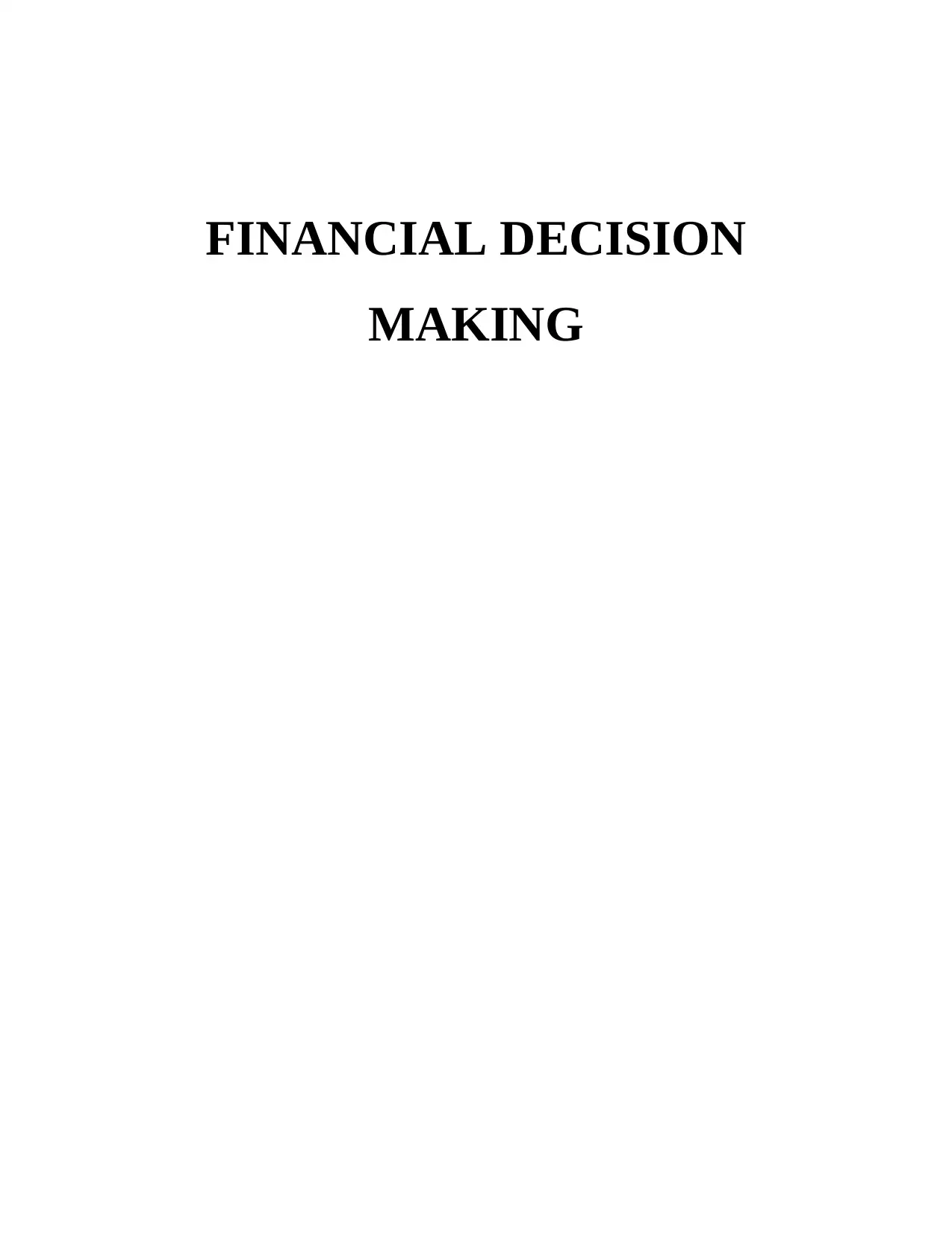
FINANCIAL DECISION
MAKING
MAKING
Paraphrase This Document
Need a fresh take? Get an instant paraphrase of this document with our AI Paraphraser
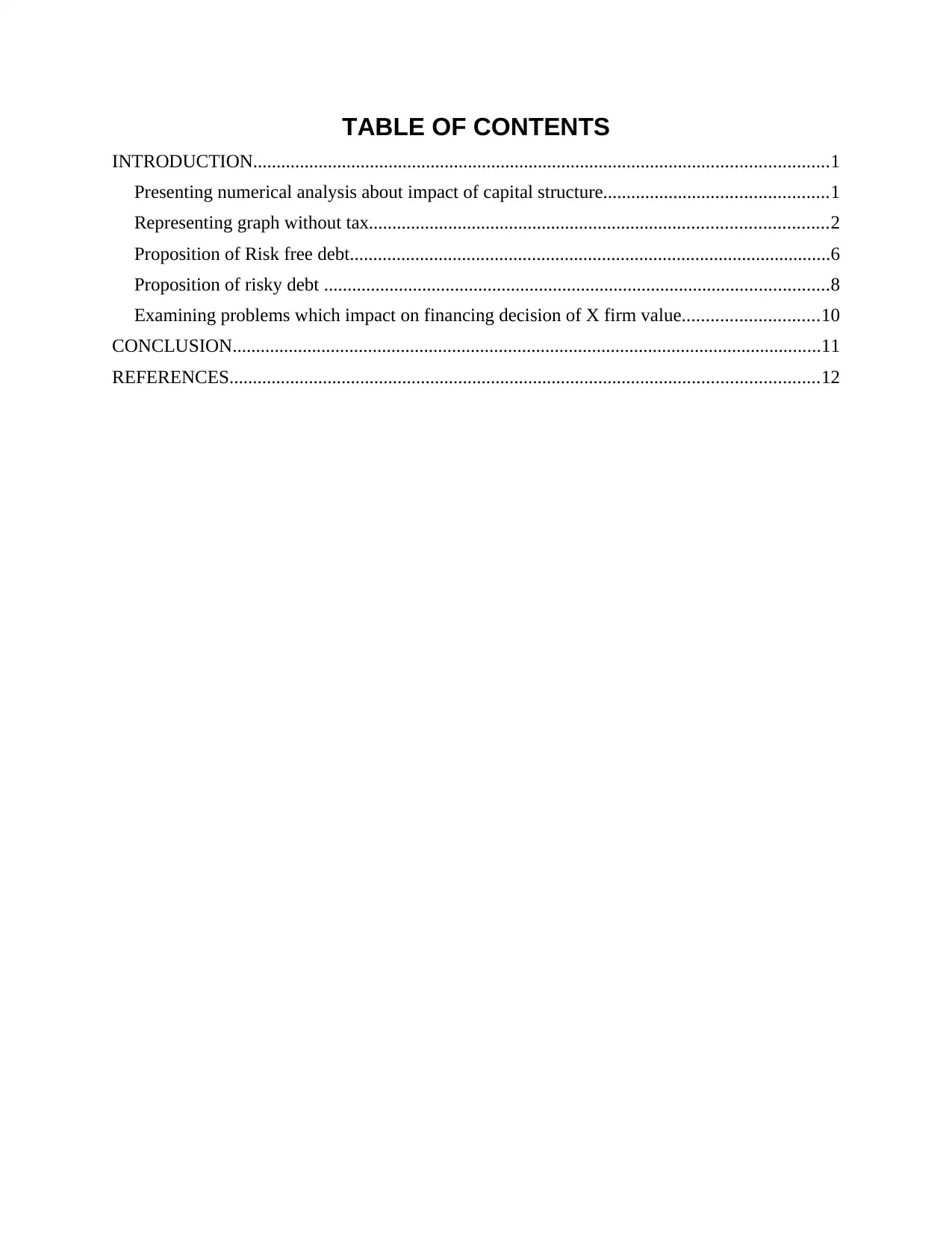
TABLE OF CONTENTS
INTRODUCTION...........................................................................................................................1
Presenting numerical analysis about impact of capital structure................................................1
Representing graph without tax..................................................................................................2
Proposition of Risk free debt.......................................................................................................6
Proposition of risky debt ............................................................................................................8
Examining problems which impact on financing decision of X firm value.............................10
CONCLUSION..............................................................................................................................11
REFERENCES..............................................................................................................................12
INTRODUCTION...........................................................................................................................1
Presenting numerical analysis about impact of capital structure................................................1
Representing graph without tax..................................................................................................2
Proposition of Risk free debt.......................................................................................................6
Proposition of risky debt ............................................................................................................8
Examining problems which impact on financing decision of X firm value.............................10
CONCLUSION..............................................................................................................................11
REFERENCES..............................................................................................................................12
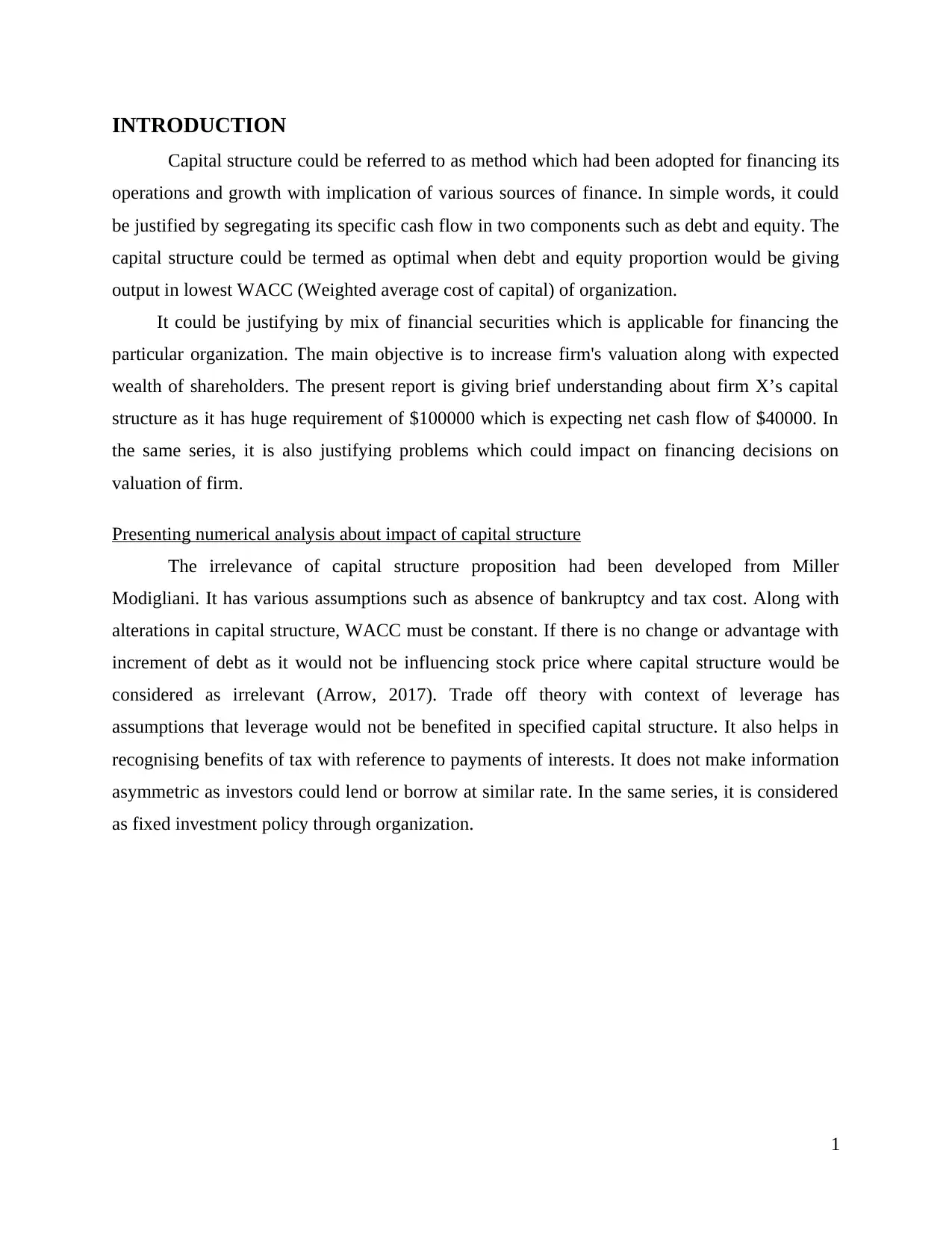
INTRODUCTION
Capital structure could be referred to as method which had been adopted for financing its
operations and growth with implication of various sources of finance. In simple words, it could
be justified by segregating its specific cash flow in two components such as debt and equity. The
capital structure could be termed as optimal when debt and equity proportion would be giving
output in lowest WACC (Weighted average cost of capital) of organization.
It could be justifying by mix of financial securities which is applicable for financing the
particular organization. The main objective is to increase firm's valuation along with expected
wealth of shareholders. The present report is giving brief understanding about firm X’s capital
structure as it has huge requirement of $100000 which is expecting net cash flow of $40000. In
the same series, it is also justifying problems which could impact on financing decisions on
valuation of firm.
Presenting numerical analysis about impact of capital structure
The irrelevance of capital structure proposition had been developed from Miller
Modigliani. It has various assumptions such as absence of bankruptcy and tax cost. Along with
alterations in capital structure, WACC must be constant. If there is no change or advantage with
increment of debt as it would not be influencing stock price where capital structure would be
considered as irrelevant (Arrow, 2017). Trade off theory with context of leverage has
assumptions that leverage would not be benefited in specified capital structure. It also helps in
recognising benefits of tax with reference to payments of interests. It does not make information
asymmetric as investors could lend or borrow at similar rate. In the same series, it is considered
as fixed investment policy through organization.
1
Capital structure could be referred to as method which had been adopted for financing its
operations and growth with implication of various sources of finance. In simple words, it could
be justified by segregating its specific cash flow in two components such as debt and equity. The
capital structure could be termed as optimal when debt and equity proportion would be giving
output in lowest WACC (Weighted average cost of capital) of organization.
It could be justifying by mix of financial securities which is applicable for financing the
particular organization. The main objective is to increase firm's valuation along with expected
wealth of shareholders. The present report is giving brief understanding about firm X’s capital
structure as it has huge requirement of $100000 which is expecting net cash flow of $40000. In
the same series, it is also justifying problems which could impact on financing decisions on
valuation of firm.
Presenting numerical analysis about impact of capital structure
The irrelevance of capital structure proposition had been developed from Miller
Modigliani. It has various assumptions such as absence of bankruptcy and tax cost. Along with
alterations in capital structure, WACC must be constant. If there is no change or advantage with
increment of debt as it would not be influencing stock price where capital structure would be
considered as irrelevant (Arrow, 2017). Trade off theory with context of leverage has
assumptions that leverage would not be benefited in specified capital structure. It also helps in
recognising benefits of tax with reference to payments of interests. It does not make information
asymmetric as investors could lend or borrow at similar rate. In the same series, it is considered
as fixed investment policy through organization.
1
⊘ This is a preview!⊘
Do you want full access?
Subscribe today to unlock all pages.

Trusted by 1+ million students worldwide
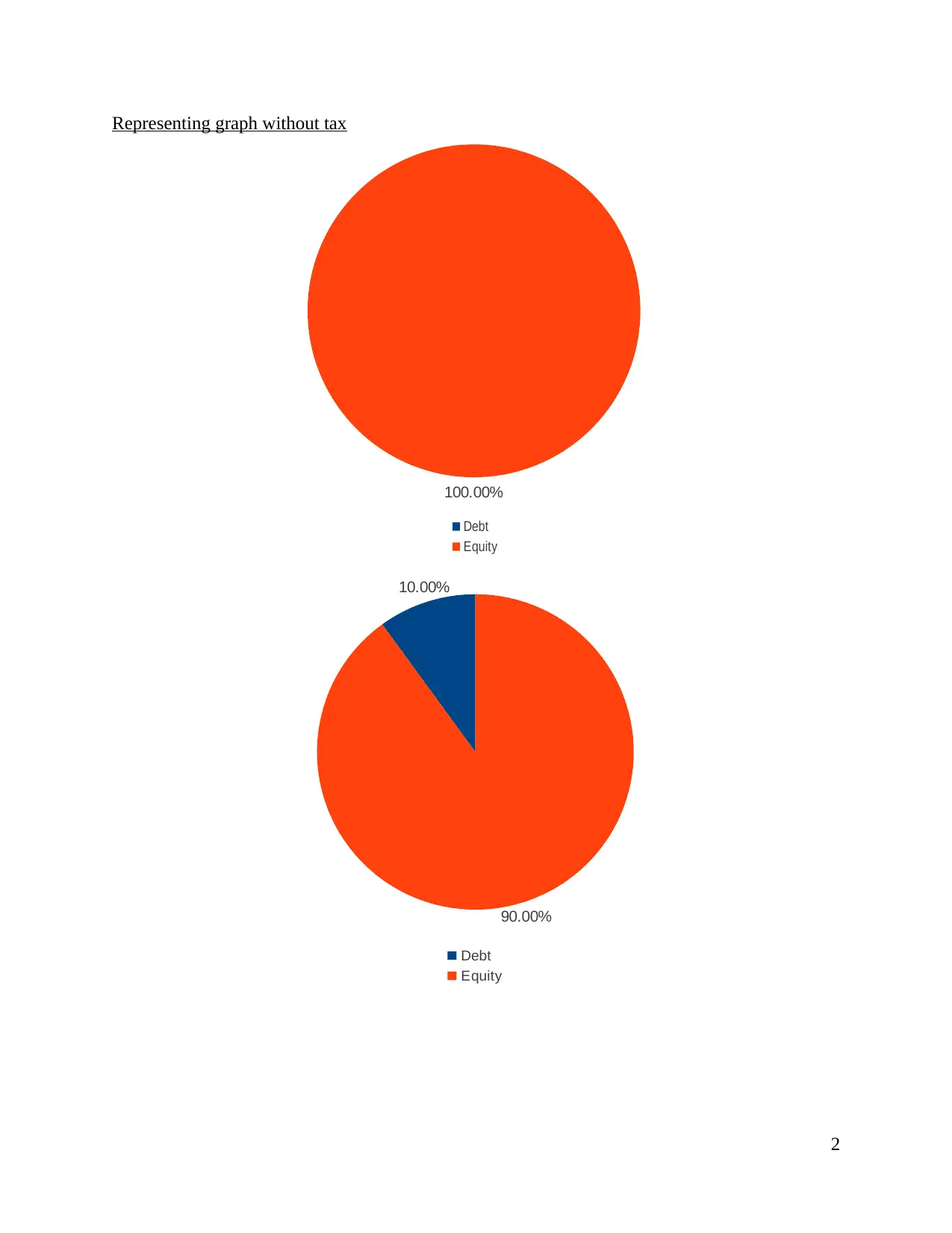
Representing graph without tax
100.00%
Debt
Equity
10.00%
90.00%
Debt
Equity
2
100.00%
Debt
Equity
10.00%
90.00%
Debt
Equity
2
Paraphrase This Document
Need a fresh take? Get an instant paraphrase of this document with our AI Paraphraser
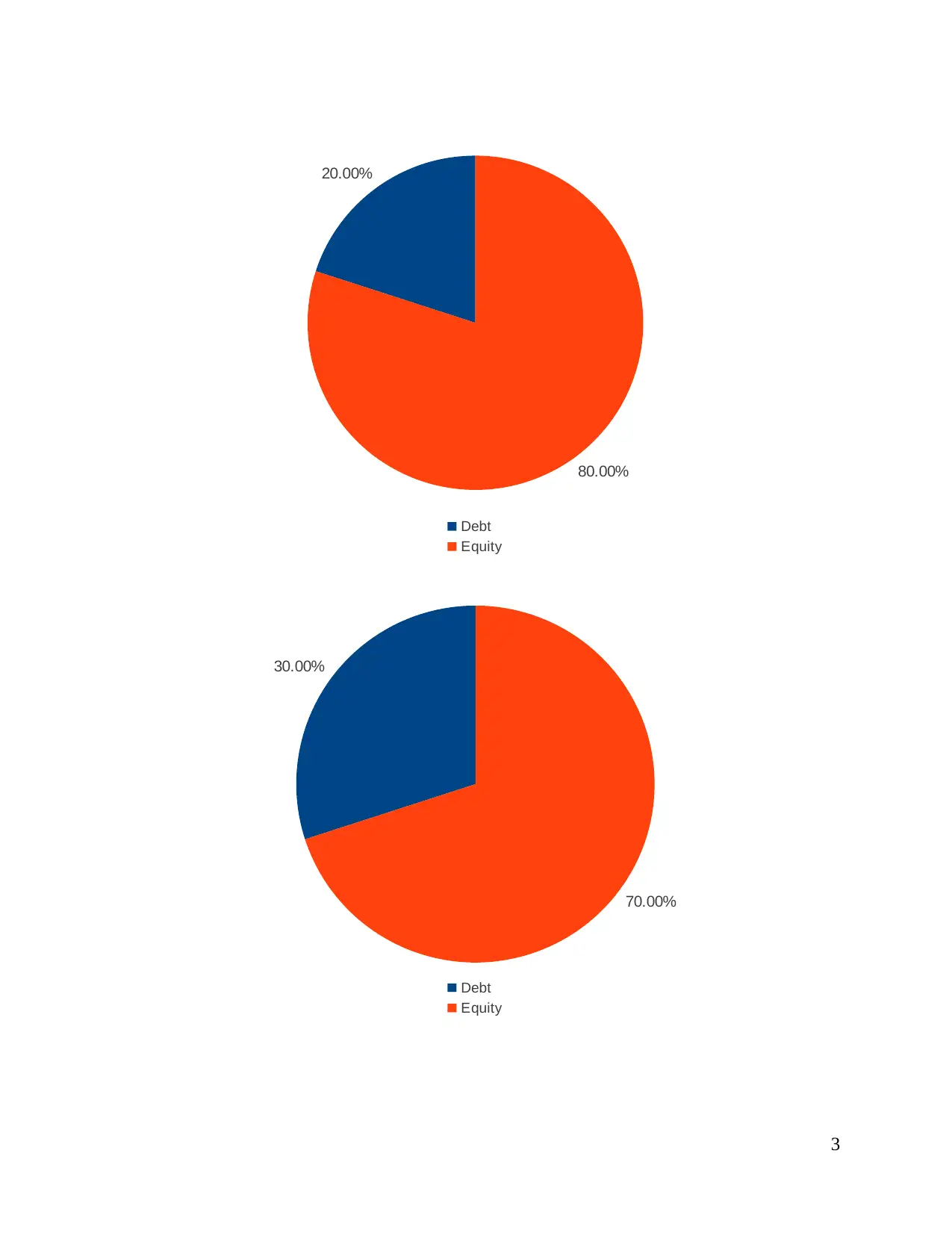
20.00%
80.00%
Debt
Equity
30.00%
70.00%
Debt
Equity
3
80.00%
Debt
Equity
30.00%
70.00%
Debt
Equity
3
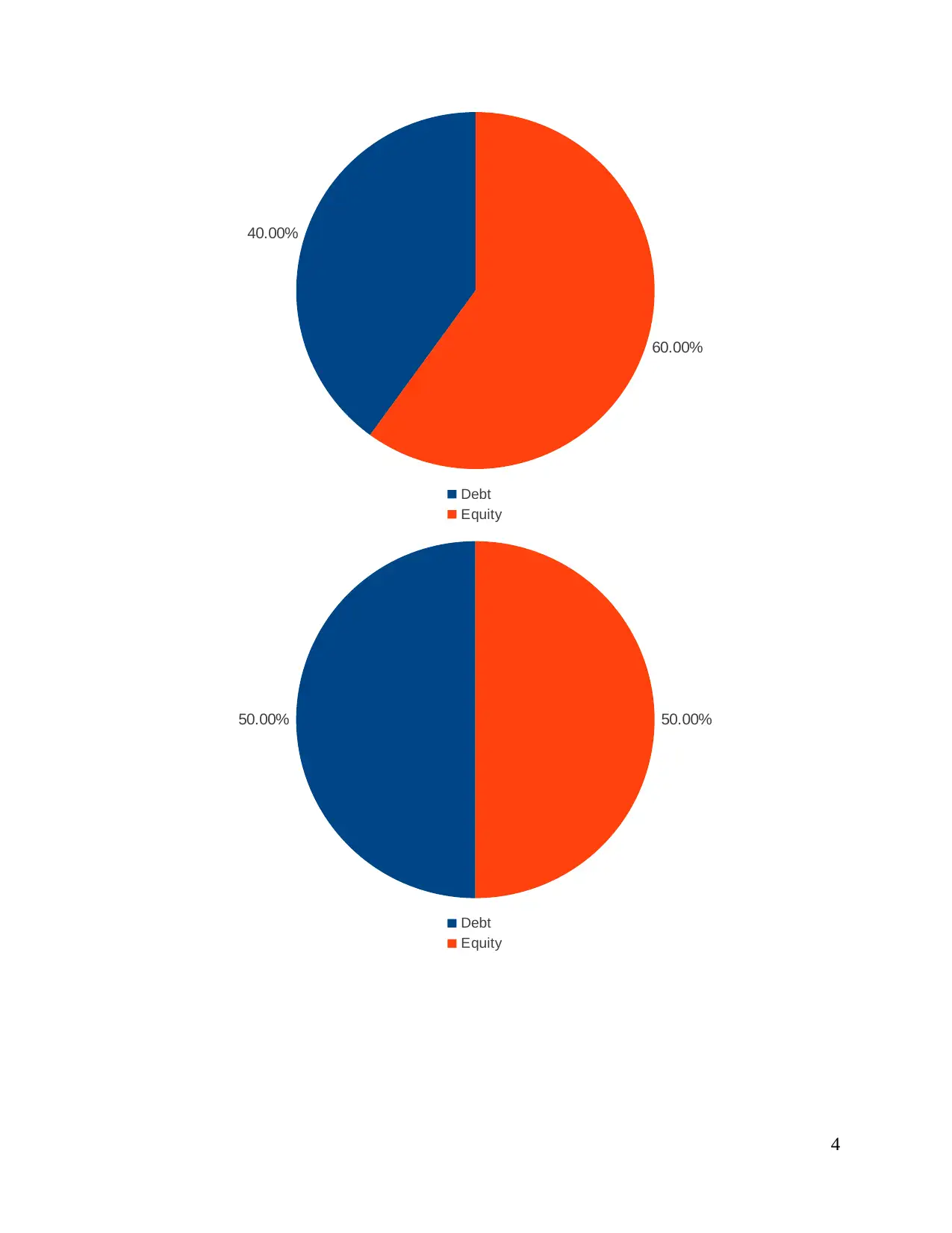
40.00%
60.00%
Debt
Equity
50.00% 50.00%
Debt
Equity
4
60.00%
Debt
Equity
50.00% 50.00%
Debt
Equity
4
⊘ This is a preview!⊘
Do you want full access?
Subscribe today to unlock all pages.

Trusted by 1+ million students worldwide
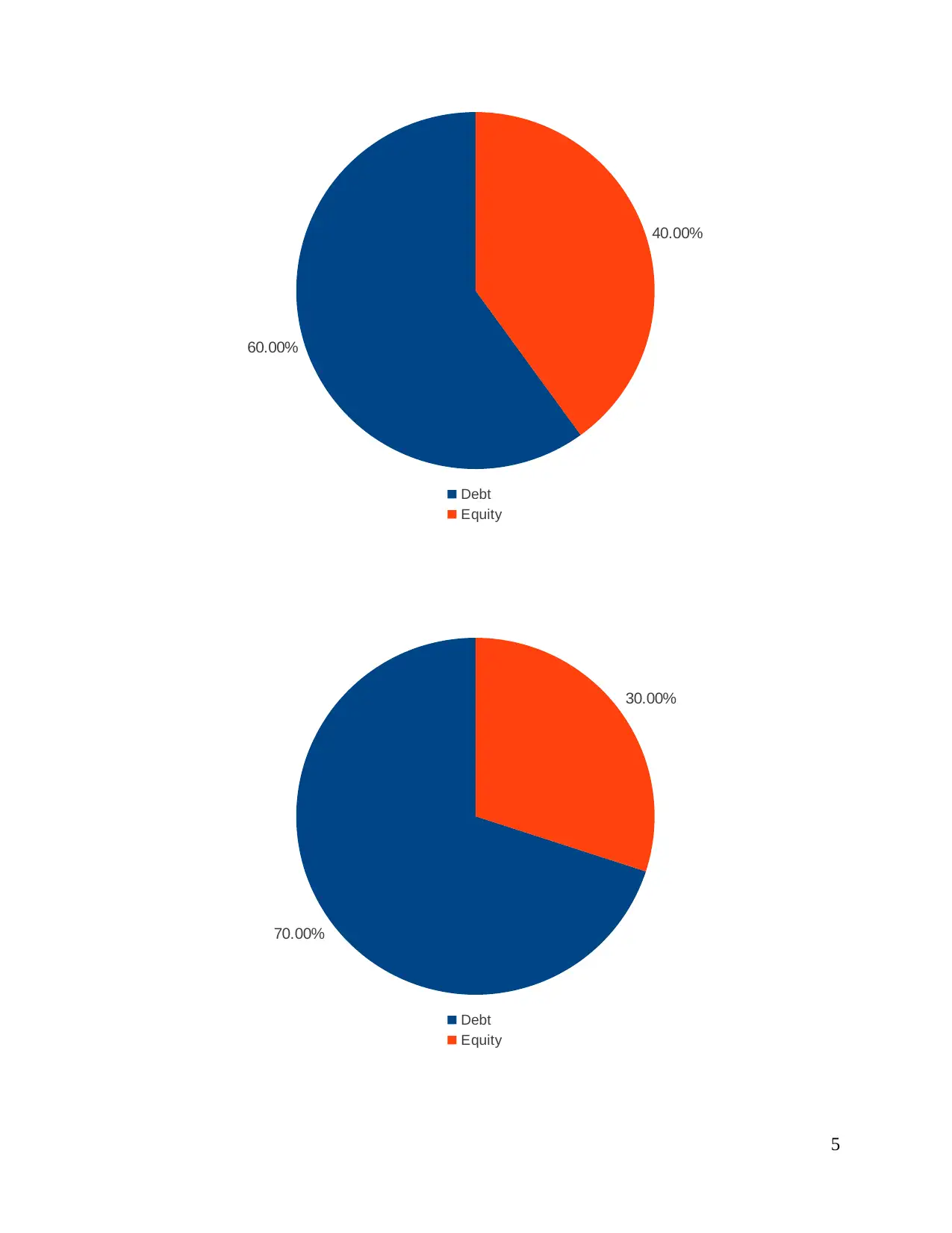
60.00%
40.00%
Debt
Equity
70.00%
30.00%
Debt
Equity
5
40.00%
Debt
Equity
70.00%
30.00%
Debt
Equity
5
Paraphrase This Document
Need a fresh take? Get an instant paraphrase of this document with our AI Paraphraser
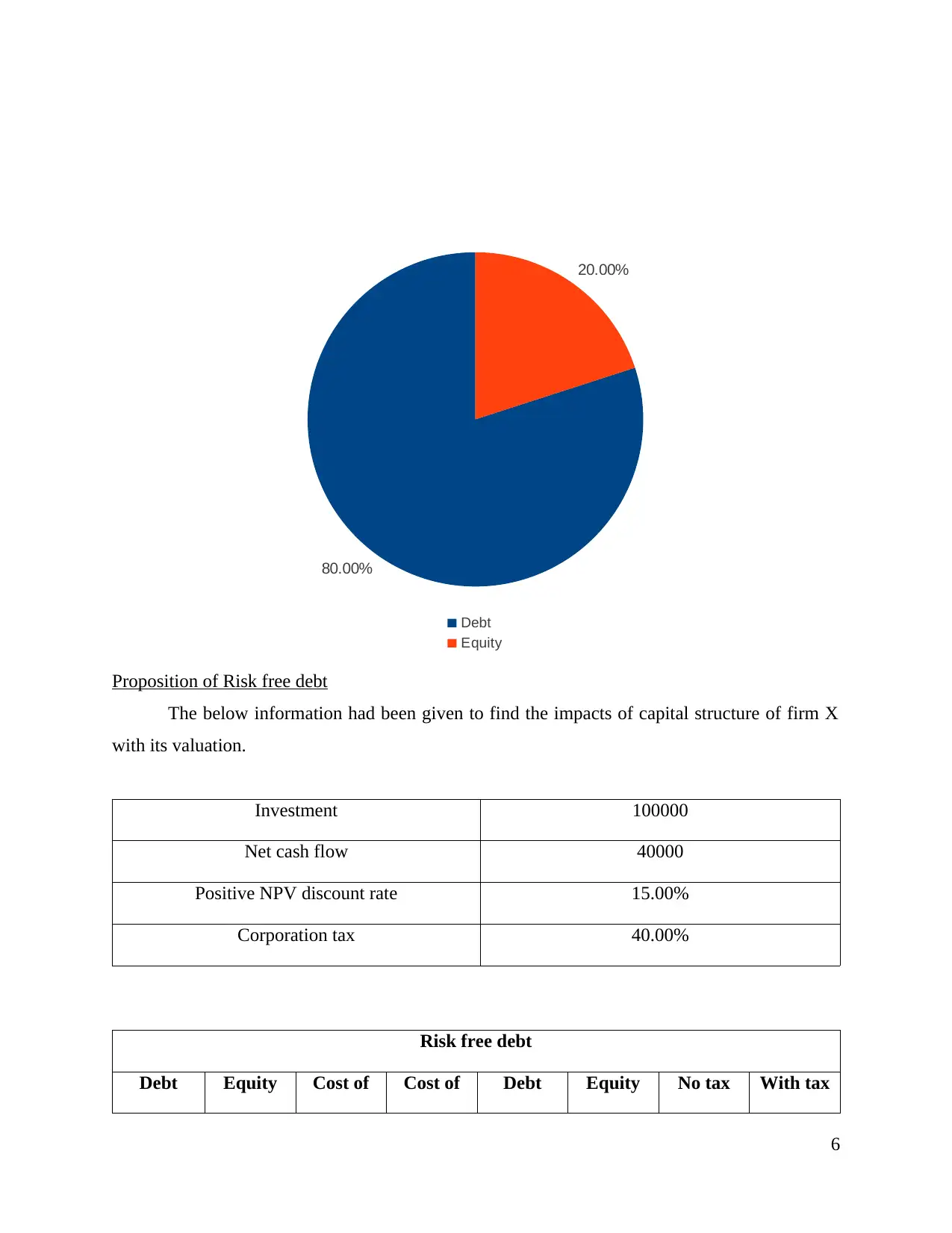
80.00%
20.00%
Debt
Equity
Proposition of Risk free debt
The below information had been given to find the impacts of capital structure of firm X
with its valuation.
Investment 100000
Net cash flow 40000
Positive NPV discount rate 15.00%
Corporation tax 40.00%
Risk free debt
Debt Equity Cost of Cost of Debt Equity No tax With tax
6
20.00%
Debt
Equity
Proposition of Risk free debt
The below information had been given to find the impacts of capital structure of firm X
with its valuation.
Investment 100000
Net cash flow 40000
Positive NPV discount rate 15.00%
Corporation tax 40.00%
Risk free debt
Debt Equity Cost of Cost of Debt Equity No tax With tax
6
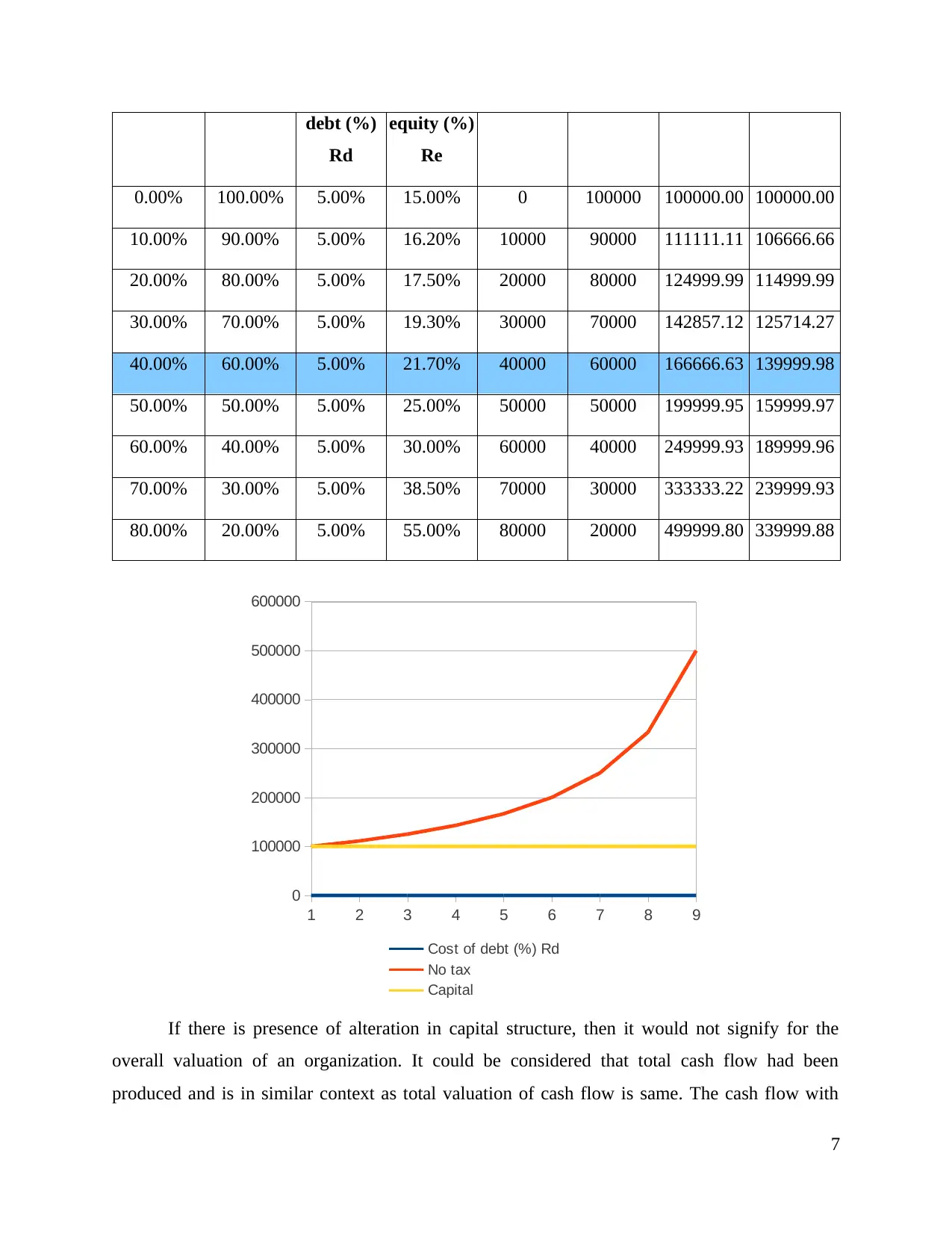
debt (%)
Rd
equity (%)
Re
0.00% 100.00% 5.00% 15.00% 0 100000 100000.00 100000.00
10.00% 90.00% 5.00% 16.20% 10000 90000 111111.11 106666.66
20.00% 80.00% 5.00% 17.50% 20000 80000 124999.99 114999.99
30.00% 70.00% 5.00% 19.30% 30000 70000 142857.12 125714.27
40.00% 60.00% 5.00% 21.70% 40000 60000 166666.63 139999.98
50.00% 50.00% 5.00% 25.00% 50000 50000 199999.95 159999.97
60.00% 40.00% 5.00% 30.00% 60000 40000 249999.93 189999.96
70.00% 30.00% 5.00% 38.50% 70000 30000 333333.22 239999.93
80.00% 20.00% 5.00% 55.00% 80000 20000 499999.80 339999.88
1 2 3 4 5 6 7 8 9
0
100000
200000
300000
400000
500000
600000
Cost of debt (%) Rd
No tax
Capital
If there is presence of alteration in capital structure, then it would not signify for the
overall valuation of an organization. It could be considered that total cash flow had been
produced and is in similar context as total valuation of cash flow is same. The cash flow with
7
Rd
equity (%)
Re
0.00% 100.00% 5.00% 15.00% 0 100000 100000.00 100000.00
10.00% 90.00% 5.00% 16.20% 10000 90000 111111.11 106666.66
20.00% 80.00% 5.00% 17.50% 20000 80000 124999.99 114999.99
30.00% 70.00% 5.00% 19.30% 30000 70000 142857.12 125714.27
40.00% 60.00% 5.00% 21.70% 40000 60000 166666.63 139999.98
50.00% 50.00% 5.00% 25.00% 50000 50000 199999.95 159999.97
60.00% 40.00% 5.00% 30.00% 60000 40000 249999.93 189999.96
70.00% 30.00% 5.00% 38.50% 70000 30000 333333.22 239999.93
80.00% 20.00% 5.00% 55.00% 80000 20000 499999.80 339999.88
1 2 3 4 5 6 7 8 9
0
100000
200000
300000
400000
500000
600000
Cost of debt (%) Rd
No tax
Capital
If there is presence of alteration in capital structure, then it would not signify for the
overall valuation of an organization. It could be considered that total cash flow had been
produced and is in similar context as total valuation of cash flow is same. The cash flow with
7
⊘ This is a preview!⊘
Do you want full access?
Subscribe today to unlock all pages.

Trusted by 1+ million students worldwide
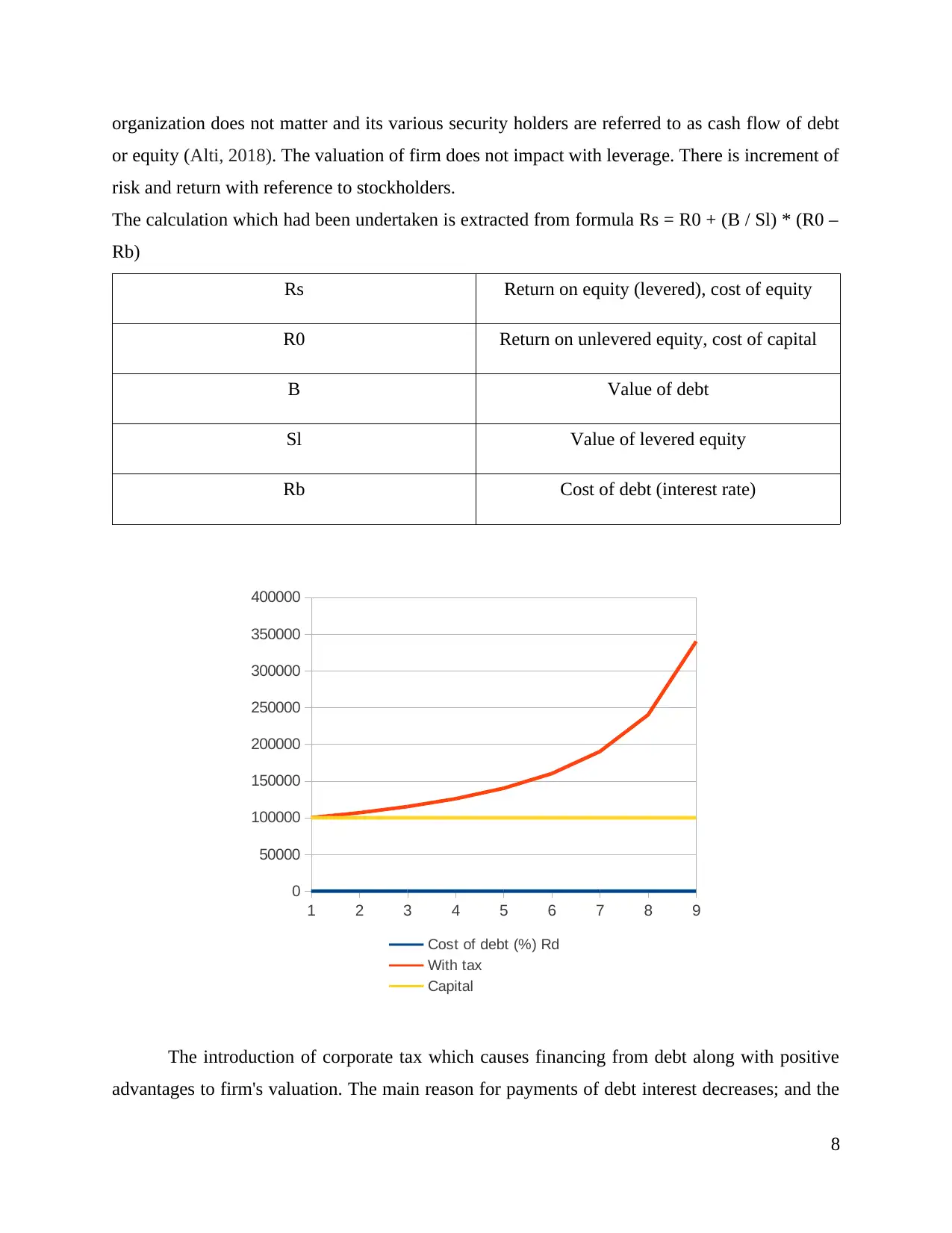
organization does not matter and its various security holders are referred to as cash flow of debt
or equity (Alti, 2018). The valuation of firm does not impact with leverage. There is increment of
risk and return with reference to stockholders.
The calculation which had been undertaken is extracted from formula Rs = R0 + (B / Sl) * (R0 –
Rb)
Rs Return on equity (levered), cost of equity
R0 Return on unlevered equity, cost of capital
B Value of debt
Sl Value of levered equity
Rb Cost of debt (interest rate)
1 2 3 4 5 6 7 8 9
0
50000
100000
150000
200000
250000
300000
350000
400000
Cost of debt (%) Rd
With tax
Capital
The introduction of corporate tax which causes financing from debt along with positive
advantages to firm's valuation. The main reason for payments of debt interest decreases; and the
8
or equity (Alti, 2018). The valuation of firm does not impact with leverage. There is increment of
risk and return with reference to stockholders.
The calculation which had been undertaken is extracted from formula Rs = R0 + (B / Sl) * (R0 –
Rb)
Rs Return on equity (levered), cost of equity
R0 Return on unlevered equity, cost of capital
B Value of debt
Sl Value of levered equity
Rb Cost of debt (interest rate)
1 2 3 4 5 6 7 8 9
0
50000
100000
150000
200000
250000
300000
350000
400000
Cost of debt (%) Rd
With tax
Capital
The introduction of corporate tax which causes financing from debt along with positive
advantages to firm's valuation. The main reason for payments of debt interest decreases; and the
8
Paraphrase This Document
Need a fresh take? Get an instant paraphrase of this document with our AI Paraphraser
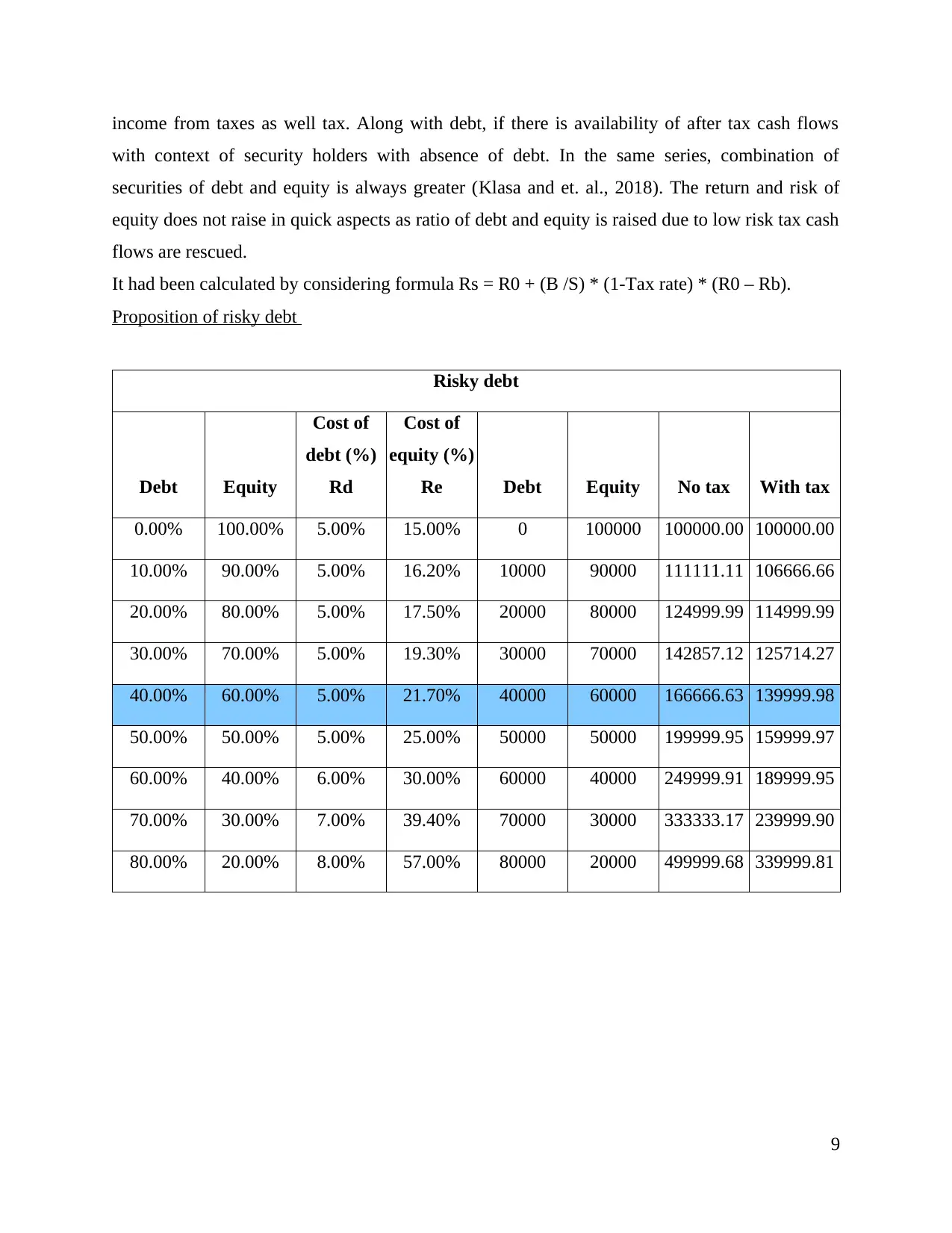
income from taxes as well tax. Along with debt, if there is availability of after tax cash flows
with context of security holders with absence of debt. In the same series, combination of
securities of debt and equity is always greater (Klasa and et. al., 2018). The return and risk of
equity does not raise in quick aspects as ratio of debt and equity is raised due to low risk tax cash
flows are rescued.
It had been calculated by considering formula Rs = R0 + (B /S) * (1-Tax rate) * (R0 – Rb).
Proposition of risky debt
Risky debt
Debt Equity
Cost of
debt (%)
Rd
Cost of
equity (%)
Re Debt Equity No tax With tax
0.00% 100.00% 5.00% 15.00% 0 100000 100000.00 100000.00
10.00% 90.00% 5.00% 16.20% 10000 90000 111111.11 106666.66
20.00% 80.00% 5.00% 17.50% 20000 80000 124999.99 114999.99
30.00% 70.00% 5.00% 19.30% 30000 70000 142857.12 125714.27
40.00% 60.00% 5.00% 21.70% 40000 60000 166666.63 139999.98
50.00% 50.00% 5.00% 25.00% 50000 50000 199999.95 159999.97
60.00% 40.00% 6.00% 30.00% 60000 40000 249999.91 189999.95
70.00% 30.00% 7.00% 39.40% 70000 30000 333333.17 239999.90
80.00% 20.00% 8.00% 57.00% 80000 20000 499999.68 339999.81
9
with context of security holders with absence of debt. In the same series, combination of
securities of debt and equity is always greater (Klasa and et. al., 2018). The return and risk of
equity does not raise in quick aspects as ratio of debt and equity is raised due to low risk tax cash
flows are rescued.
It had been calculated by considering formula Rs = R0 + (B /S) * (1-Tax rate) * (R0 – Rb).
Proposition of risky debt
Risky debt
Debt Equity
Cost of
debt (%)
Rd
Cost of
equity (%)
Re Debt Equity No tax With tax
0.00% 100.00% 5.00% 15.00% 0 100000 100000.00 100000.00
10.00% 90.00% 5.00% 16.20% 10000 90000 111111.11 106666.66
20.00% 80.00% 5.00% 17.50% 20000 80000 124999.99 114999.99
30.00% 70.00% 5.00% 19.30% 30000 70000 142857.12 125714.27
40.00% 60.00% 5.00% 21.70% 40000 60000 166666.63 139999.98
50.00% 50.00% 5.00% 25.00% 50000 50000 199999.95 159999.97
60.00% 40.00% 6.00% 30.00% 60000 40000 249999.91 189999.95
70.00% 30.00% 7.00% 39.40% 70000 30000 333333.17 239999.90
80.00% 20.00% 8.00% 57.00% 80000 20000 499999.68 339999.81
9
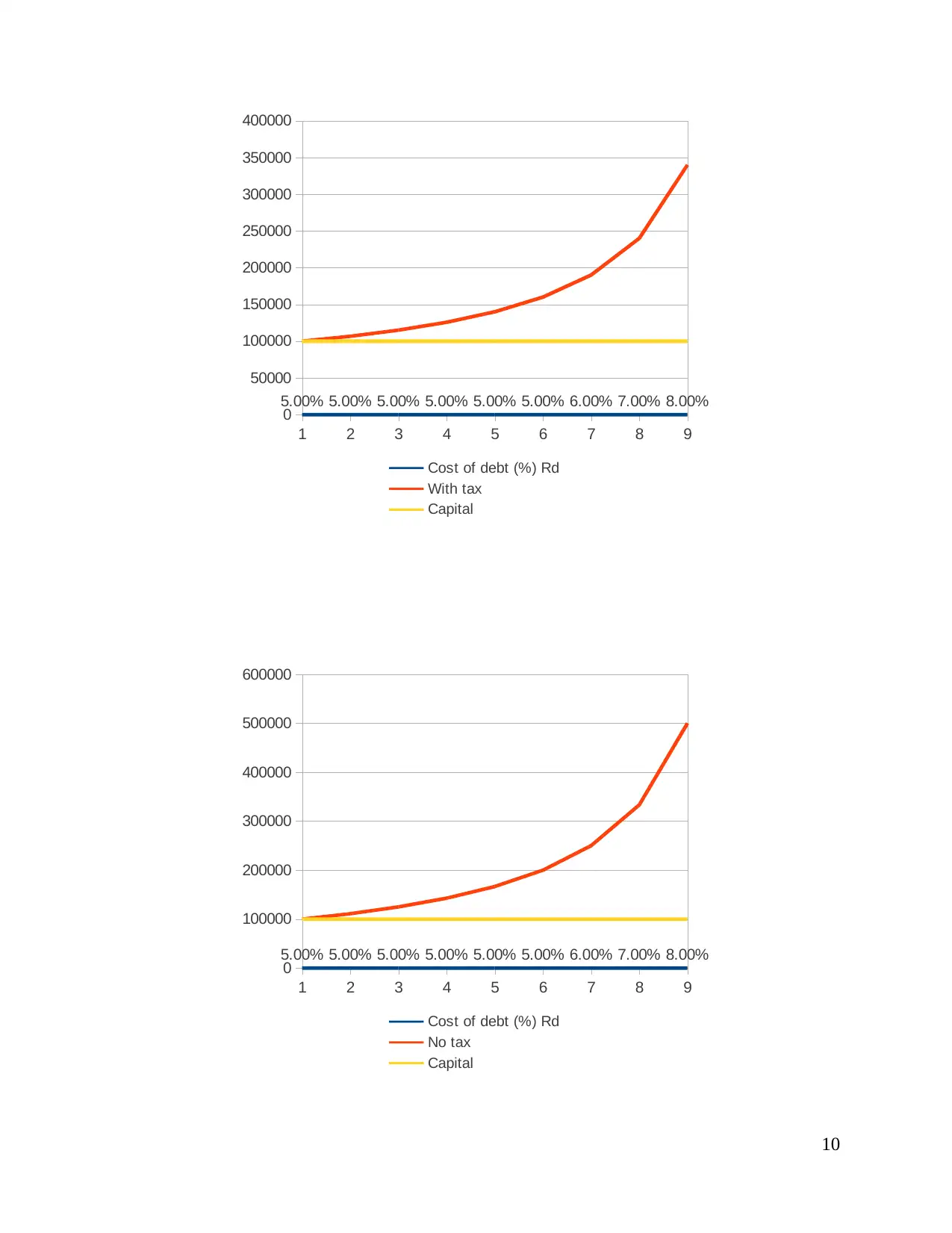
1 2 3 4 5 6 7 8 9
0
50000
100000
150000
200000
250000
300000
350000
400000
5.00% 5.00% 5.00% 5.00% 5.00% 5.00% 6.00% 7.00% 8.00%
Cost of debt (%) Rd
With tax
Capital
1 2 3 4 5 6 7 8 9
0
100000
200000
300000
400000
500000
600000
5.00% 5.00% 5.00% 5.00% 5.00% 5.00% 6.00% 7.00% 8.00%
Cost of debt (%) Rd
No tax
Capital
10
0
50000
100000
150000
200000
250000
300000
350000
400000
5.00% 5.00% 5.00% 5.00% 5.00% 5.00% 6.00% 7.00% 8.00%
Cost of debt (%) Rd
With tax
Capital
1 2 3 4 5 6 7 8 9
0
100000
200000
300000
400000
500000
600000
5.00% 5.00% 5.00% 5.00% 5.00% 5.00% 6.00% 7.00% 8.00%
Cost of debt (%) Rd
No tax
Capital
10
⊘ This is a preview!⊘
Do you want full access?
Subscribe today to unlock all pages.

Trusted by 1+ million students worldwide
1 out of 15
Related Documents
Your All-in-One AI-Powered Toolkit for Academic Success.
+13062052269
info@desklib.com
Available 24*7 on WhatsApp / Email
![[object Object]](/_next/static/media/star-bottom.7253800d.svg)
Unlock your academic potential
Copyright © 2020–2025 A2Z Services. All Rights Reserved. Developed and managed by ZUCOL.





